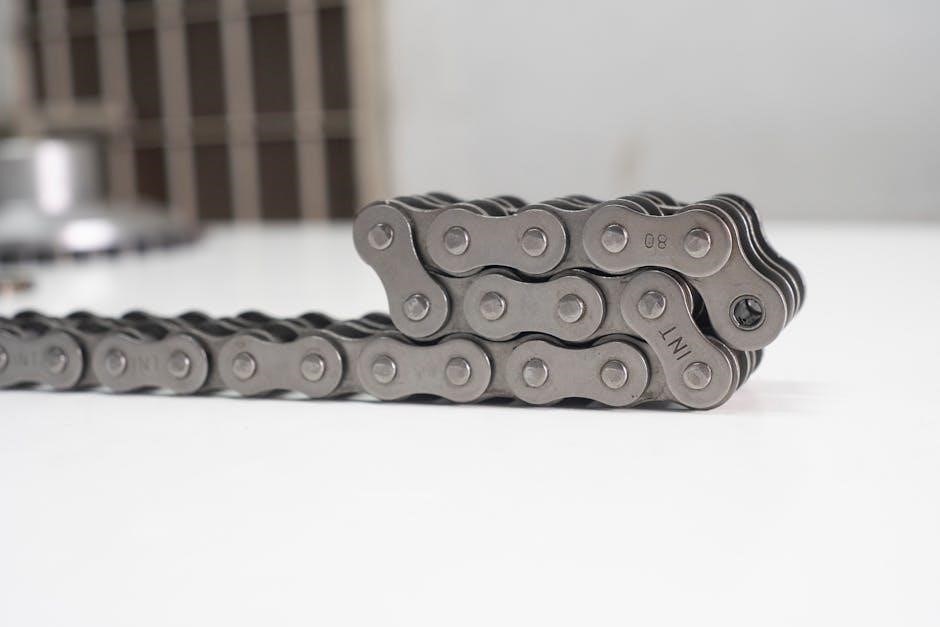Mechanics of Solids Textbook PDF: A Comprehensive Guide
Mechanics of Solids is a core engineering subject. This guide explores readily available PDF textbooks. It will cover fundamental concepts, stress-strain analysis, and applications. This also includes finding appropriate resources for study and understanding solid mechanics principles.
Mechanics of Solids, also known as Strength of Materials, is a fundamental branch of engineering mechanics that studies the behavior of solid materials under various loading conditions. It forms the bedrock for understanding how structures and components respond to external forces, stresses, and strains. This introduction will lay the groundwork for delving into the complexities of solid mechanics.

The subject’s core lies in analyzing internal stresses and deformations within solid bodies caused by applied loads, such as tension, compression, shear, bending, and torsion. By understanding these internal forces and their effects, engineers can design safe, efficient, and reliable structures and machines. From bridges and buildings to aircraft and automobiles, the principles of solid mechanics are indispensable in a wide range of engineering applications.
This field also encompasses the study of material properties, including elasticity, plasticity, and failure criteria. These properties dictate how a material deforms and ultimately fails under load. Furthermore, solid mechanics incorporates energy methods to analyze structural behavior and predict stability. The study is essential for engineering students, providing them analytical skills and the ability to solve engineering problems.
Fundamental Concepts in Solid Mechanics
Solid mechanics relies on several fundamental concepts that are crucial for understanding material behavior under load. These concepts provide the foundation for analyzing stress, strain, and deformation in solid bodies. Among the most important are stress and strain, which quantify the internal forces and deformations within a material, respectively. Stress represents the force acting per unit area, while strain measures the deformation relative to the original size.
Another key concept is Hooke’s Law, which describes the linear relationship between stress and strain for elastic materials. This law states that stress is proportional to strain, with the constant of proportionality known as the modulus of elasticity. This is the base to understand elastic behaviour of solids. Understanding material properties like Young’s modulus, Poisson’s ratio, and shear modulus is also essential.
Furthermore, the concept of equilibrium plays a vital role in solid mechanics. Equilibrium requires that the sum of forces and moments acting on a body must be zero, ensuring that the body remains at rest or in constant motion. Understanding the types of forces, moments, supports, and reactions is also essential. By applying these fundamental concepts, engineers can analyze the behavior of solid materials under various loading scenarios and design safe and reliable structures.
Stress Analysis in Solid Materials
Stress analysis is a crucial aspect of solid mechanics. It involves determining the internal stresses within a solid material subjected to external loads. The goal is to understand how these stresses are distributed and whether they exceed the material’s strength, potentially leading to failure. Stress can be normal (perpendicular to the surface) or shear (parallel to the surface).
Engineers use various methods for stress analysis, including analytical techniques, numerical simulations, and experimental measurements. Analytical methods involve applying mathematical equations and principles of mechanics to calculate stresses in simple geometries and loading conditions. Numerical simulations, such as finite element analysis (FEA), are used for more complex structures and loading scenarios, to solve for stresses computationally.
Stress analysis is essential for designing safe and reliable structures and components. By accurately predicting stresses, engineers can ensure that materials are used efficiently and that structures can withstand the intended loads without failure. Understanding stress concentrations, which occur at geometric discontinuities or points of load application, is also crucial in stress analysis. Proper design and material selection can mitigate stress concentrations and prevent premature failure.
Strain Analysis in Solid Materials
Strain analysis complements stress analysis by examining the deformation of solid materials under load. Strain quantifies the amount of deformation experienced by a material, representing the change in length or shape relative to its original dimensions. Like stress, strain can be normal (elongation or contraction) or shear (change in angle). Understanding strain distribution is critical for predicting material behavior and structural integrity.
Various techniques are employed in strain analysis, including experimental methods like strain gauges and digital image correlation (DIC), as well as numerical methods such as finite element analysis (FEA). Strain gauges measure the strain at a specific point on a material’s surface. DIC uses digital images to track the displacement of points on a material, allowing for full-field strain mapping. FEA simulates the deformation of a material under load, providing detailed strain distributions.
Strain analysis is essential for assessing the performance and durability of structures and components. By analyzing strain patterns, engineers can identify areas of high deformation and potential failure. This information informs design modifications, material selection, and load capacity assessments. Furthermore, strain analysis helps validate analytical and numerical models, ensuring accurate predictions of structural behavior. The interplay between stress and strain analysis provides a comprehensive understanding of a material’s response to external forces.
Constitutive Relations in Solid Mechanics
Constitutive relations are fundamental to solid mechanics. They mathematically link stress and strain within a material. These relationships describe a material’s inherent behavior under load, dictating how it deforms in response to applied forces. Different materials exhibit different constitutive behaviors, necessitating various models. These accurately capture these behaviors.
The simplest constitutive relation is linear elasticity, often described by Hooke’s Law. This law states that stress is directly proportional to strain. This is valid for many materials under small deformations. However, many materials exhibit nonlinear behavior, especially at higher stress levels or under complex loading conditions. Nonlinear constitutive models can account for plasticity, viscoelasticity, and other complex phenomena.
Choosing the appropriate constitutive relation is crucial for accurate analysis and prediction. Material properties, temperature, and loading rate influence this choice. Experimental data is often used to calibrate and validate constitutive models. Accurate modeling of material behavior is crucial for designing safe and reliable structures. It also ensures accurate predictions of their performance under various loading scenarios. Advanced models can simulate material response under extreme conditions. These include high temperatures, impact loads, and fatigue. These contribute to safer and more durable engineering designs.
Elastic Behavior of Solids
Elastic behavior in solids is a fundamental concept in mechanics. It defines the material’s ability to return to its original shape after removing applied forces. This behavior is characterized by a linear relationship between stress and strain, as described by Hooke’s Law. The elastic limit defines the maximum stress a material can withstand without permanent deformation.
Understanding elastic behavior is crucial for designing structures. It ensures they function without permanent deformation under normal loads. Materials like steel, aluminum, and rubber exhibit varying degrees of elasticity. Their elastic properties are quantified by parameters such as Young’s modulus, shear modulus, and Poisson’s ratio. These parameters are essential for stress analysis and predicting structural deformation.
When a solid deforms elastically, the energy applied is stored within the material as potential energy. This energy is released when the load is removed, allowing the material to recover its original shape. However, exceeding the elastic limit leads to plastic deformation. This results in permanent changes in the material’s geometry. The study of elastic behavior is vital in many engineering applications. It ensures structural integrity and prevents failure. Finite element analysis relies heavily on accurate modeling of elastic behavior. This provides reliable predictions of structural response under complex loading conditions. Advanced materials with enhanced elastic properties are continuously being developed. This meets the growing demands for high-performance structures.
Plastic Behavior of Solids
Plastic behavior in solids occurs when a material undergoes permanent deformation after exceeding its elastic limit. Unlike elastic deformation, plastic deformation is non-recoverable. The material does not return to its original shape upon unloading. This behavior is crucial in metal forming processes and structural design under extreme loads.
The onset of plastic behavior is typically defined by yield criteria, such as the von Mises or Tresca criteria. These criteria specify the stress state at which plastic deformation begins. Beyond the yield point, the material experiences strain hardening. This requires increasing stress to cause further deformation. Understanding plastic behavior is essential for predicting the ultimate strength of materials and designing structures that can withstand large deformations without failure.
Plastic deformation involves the movement of dislocations within the material’s crystalline structure. This dislocation movement allows the material to deform permanently. The study of plastic behavior also includes analyzing the material’s response under various loading conditions, such as tension, compression, and shear. This is crucial for designing components that undergo significant plastic deformation during their service life. Finite element simulations are often used to model plastic behavior and predict the material’s response under complex loading scenarios. Advanced constitutive models are developed to accurately capture the material’s plastic response, including strain rate sensitivity and temperature effects. These models are crucial for simulating manufacturing processes. This includes forging, rolling, and extrusion, where plastic deformation plays a dominant role.
Fracture and Failure Theories
Fracture and failure theories are critical in solid mechanics for predicting when a material will break or fail under specific conditions. These theories provide a framework for understanding the mechanisms of fracture; They help engineers design structures that can withstand anticipated loads and prevent catastrophic failures. Fracture mechanics focuses on the behavior of cracks in materials. It also assesses the stress intensity factor at the crack tip.
Several failure theories exist, each applicable under different loading conditions and material properties. The maximum principal stress theory predicts failure when the maximum principal stress reaches the material’s ultimate tensile strength. The maximum shear stress theory, also known as the Tresca criterion, predicts failure when the maximum shear stress exceeds the material’s shear strength. The von Mises criterion, based on the distortion energy theory, predicts failure when the distortion energy reaches a critical value. This is often used for ductile materials.
Fracture toughness is a material property that quantifies its resistance to crack propagation. Materials with high fracture toughness can withstand larger cracks before failure. Environmental factors, such as temperature and corrosive environments, can significantly influence fracture and failure. Fatigue failure occurs due to repeated loading and unloading, leading to crack initiation and propagation over time. Creep failure happens under sustained stress at elevated temperatures, causing gradual deformation and eventual fracture. Understanding these theories helps engineers select appropriate materials and design structures that can operate safely under various conditions. The theories also contribute to the development of non-destructive testing methods for detecting flaws before they lead to structural failure.

Energy Methods in Solid Mechanics
Energy methods in solid mechanics offer powerful tools for analyzing structural behavior. They provide alternative approaches to solving problems related to displacement and stress. Unlike direct methods that involve solving differential equations, energy methods focus on the overall energy state of the system. These techniques are beneficial for complex structures where direct solutions are difficult to obtain.
One fundamental principle is the principle of virtual work, which states that for a system in equilibrium, the virtual work done by external forces equals the virtual strain energy stored within the body. This principle is used to determine displacements and reactions in structures. Castigliano’s theorems are another set of energy methods. Castigliano’s first theorem relates the partial derivative of the total strain energy with respect to a force to the displacement at the point of application of that force. Castigliano’s second theorem relates the partial derivative of the complementary energy with respect to a displacement to the force applied at that point.
The Rayleigh-Ritz method is an approximate energy method used to estimate the natural frequencies and mode shapes of vibrating structures. This method involves assuming a displacement field and minimizing the total potential energy of the system. The finite element method, widely used in engineering analysis, is also rooted in energy principles. It discretizes a structure into small elements. It then approximates the behavior of each element using energy formulations. Energy methods provide insights into structural stability, buckling, and dynamic response. They are valuable for optimizing designs and ensuring structural integrity.
Applications in Engineering
Mechanics of solids principles find extensive applications across diverse engineering disciplines, ensuring structural integrity and optimal performance. In civil engineering, these principles are crucial for designing bridges, buildings, and other infrastructure. Stress analysis helps determine the load-bearing capacity of structural elements, preventing failures. Material properties, such as elasticity and yield strength, are considered to ensure safety and durability.
In mechanical engineering, mechanics of solids is essential for designing machine components, pressure vessels, and automotive parts. Stress concentrations at geometric discontinuities are carefully analyzed to prevent fatigue and fracture. Finite element analysis simulates the behavior of complex mechanical systems under various loading conditions. In aerospace engineering, the design of aircraft structures relies heavily on mechanics of solids. Lightweight materials with high strength-to-weight ratios are used to minimize weight while maintaining structural integrity.
Composite materials, with tailored properties, are employed to enhance performance. Biomedical engineering utilizes mechanics of solids to design prosthetics, implants, and medical devices. Biocompatibility and mechanical compatibility are crucial for successful integration with the human body. In geotechnical engineering, soil mechanics, a branch of mechanics of solids, is used to analyze the stability of slopes, foundations, and retaining walls. Understanding soil behavior under stress is essential for preventing landslides and ensuring the stability of earth structures. These applications demonstrate the breadth and depth of mechanics of solids in solving real-world engineering problems.
Recommended Textbooks and Resources
For a comprehensive understanding of mechanics of solids, several excellent textbooks and resources are recommended. “Mechanics of Materials” by Gere and Timoshenko is considered a classic, providing a thorough treatment of fundamental concepts. “Applied Mechanics of Solids” by Allan F. Bower offers a more advanced perspective, suitable for graduate students and researchers. “Fundamentals of Solid Mechanics” by Y.C. Fung is another valuable resource, known for its rigorous mathematical approach.
Online resources, such as lecture notes and example problems from universities like MIT and Harvard, can supplement textbook study. Websites like Coursera and edX offer courses on mechanics of solids, providing structured learning experiences. For practical applications, software like ANSYS and Abaqus can be used for finite element analysis. These tools enable engineers to simulate the behavior of complex structures and validate their designs.

Additionally, professional organizations like ASME and ASCE offer publications and conferences that provide insights into the latest research and developments in mechanics of solids. Accessing these resources can help students and professionals stay current in the field. Exploring a combination of textbooks, online materials, and software tools ensures a well-rounded education in mechanics of solids, preparing individuals for successful careers in engineering. Don’t forget to explore university libraries for additional materials.
Where to Find Mechanics of Solids Textbook PDFs
Finding Mechanics of Solids textbook PDFs requires navigating various online resources. University libraries often provide access to digital versions of textbooks through their online portals. Students can typically download these PDFs for academic use, subject to copyright restrictions. Websites like ResearchGate and Academia.edu may host shared lecture notes and excerpts from textbooks, although full PDFs are less common due to copyright concerns.
Open educational resources (OER) platforms, such as Open Textbook Library, offer freely accessible textbooks that can be downloaded as PDFs. These resources are often licensed under Creative Commons, allowing for legal sharing and distribution. Online forums and communities dedicated to engineering may also contain links to PDFs, but users should exercise caution and verify the legality of downloading copyrighted material.
It is important to respect copyright laws when searching for textbook PDFs. Consider purchasing digital versions from official publishers or exploring legal alternatives like library loans and rentals. While readily available online, unauthorized downloads can infringe on intellectual property rights. Prioritize ethical and legal means of accessing textbooks to support authors and publishers in their work. Always check the legitimacy of the source before downloading any PDF file to avoid potential security risks.
